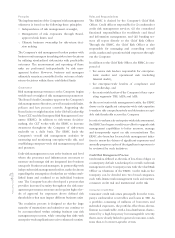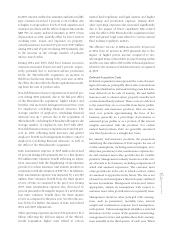American Express 2004 Annual Report Download - page 54
Download and view the complete annual report
Please find page 54 of the 2004 American Express annual report below. You can navigate through the pages in the report by either clicking on the pages listed below, or by using the keyword search tool below to find specific information within the annual report.
principally fund cardmember loans originated from
the Company’s lending activities. In addition, two trusts
are used by the Company in connection with the
securitization and sale of receivables and loans gener-
ated in the ordinary course of TRS’ card businesses. The
assets securitized consist principally of U.S. consumer
cardmember receivables and loans arising from TRS’
charge card and lending activities.
TRS’ funding needs are met primarily through the fol-
lowing sources:
©Commercial paper,
©Bank notes, institutional CDs and Fed Funds,
©Medium-term notes and senior unsecured debentures,
©Asset securitizations, and
©Long-term committed bank borrowing facilities in
selected non-U.S. markets.
TRS’ debt offerings are placed either directly, as in the
case of its commercial paper program through Credco,
or through securities brokers or underwriters. In certain
international markets, bank borrowings are used to par-
tially fund cardmember receivables and loans. During
2004, TRS diversified its funding base by borrowing
under committed bank credit facilities as part of a
change in local funding strategies in select international
markets.
The following table highlights TRS’ outstanding debt
(including intercompany balances) and off-balance
sheet securitizations as of December 31, 2004 and 2003:
December 31, (Billions) 2004 2003
Short-term debt $17.2 $21.8
Long-term debt 28.3 16.6
Total debt (GAAP basis) $45.5 $38.4
Off-balance sheet securitizations
(a)
20.3 19.5
Total debt (managed basis) $65.8 $57.9
(a) Includes securitized equipment leasing receivables of $0.1 billion at
December 31, 2003.
Short-term debt is defined as any debt with an original
maturity of 12 months or less. The commercial paper
market represents the primary source of short-term fund-
ing for the Company. Credco’s commercial paper is a
widely recognized name among short-term investors
and is a principal source of debt for the Company. At
December 31, 2004, Credco had $3.8 billion of commer-
cial paper outstanding, net of certain short-term invest-
ments. The outstanding amount, net of certain short-term
investments, declined $5.0 billion or 57 percent from a
year ago primarily as a result of a change in Credco’s
funding strategy in certain international markets. Average
commercial paper outstanding, net of certain short-term
investments, was $5.7 billion and $7.7 billion in 2004 and
2003, respectively. TRS currently manages the level of
commercial paper outstanding, net of certain short-term
investments, such that the ratio of its committed bank
credit facility to total short-term debt, which consists
mainly of commercial paper, is not less than 100%.
Centurion Bank and FSB raise short-term debt through
various instruments. Bank notes issued and Fed Funds
purchased by Centurion Bank and FSB totaled approxi-
mately $5.2 billion as of December 31, 2004. Centurion
Bank and FSB also raise customer deposits through the
issuance of certificates of deposits to retail and institu-
tional customers. As of December 31, 2004, Centurion
Bank and FSB held $4.5 billion in customer deposits.
Centurion Bank and FSB maintain $320 million and
$300 million, respectively, of committed bank credit
lines as a backup to short-term funding programs. Long-
term funding needs are met principally through the sale
of cardmember loans in securitization transactions. The
Asset/Liability Committees of Centurion Bank and FSB
provide management oversight with respect to formu-
lating and ratifying funding strategy and to ensuring that
all funding policies and requirements are met.
Medium- and long-term debt is raised through the offer-
ing of debt securities in the U.S. and international capital
markets. Medium-term debt is generally defined as any
debt with an original maturity greater than 12 months
but less than 36 months. Long-term debt is generally
defined as any debt with an original maturity greater
than 36 months. At December 31, 2004, TRS and its sub-
sidiaries had the following amounts of medium- and
long-term debt outstanding (including intercompany
balances):
December 31, 2004
(Billions)
Medium-term
Debt
Long-term
Debt
Total Medium-
and Long-term,
Debt
Credco $12.2 $6.4 $18.6
Centurion Bank 3.0 1.4 4.4
FSB 1.6 — 1.6
Other Subsidiaries 1.7 2.0 3.7
Total TRS $18.5 $9.8 $28.3
In 2005, TRS along with its subsidiaries, Credco, Centu-
rion Bank and FSB, as well as through its securitization
trusts, expects to issue approximately $13 billion in
medium- and long-term debt to fund business growth
and refinance a portion of maturing medium- and long-
term debt. The Company expects that its planned fund-
ing during the next year will be met through a combi-
nation of sources similar to those on which it currently
relies. However, the Company continues to assess its
AXP
AR.04
52
Financial Review
























